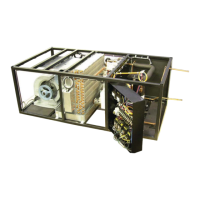19
is too cold can cause excessive dehumidifi cation and coil sweating. Fluid temperature that is too
high can cause the indoor space temperature to rise. This can cause the optional microprocessor
controls to lock out the energy saver mode for one hour while it reverts back to compressorized
cooling. Adjust the setpoints of the thermostats to allow the maximum free cooling time. Overcooling
or undercooling the fl uid should be avoided.
Every application will have a different ambient temperature and indoor heat load/
air distribution profi le. Therefore it is not possible to dictate the exact water-sensing
thermostat setpoints. Field adjustments are typical to allow fi ne-tuning to specifi c
conditions
5.0 CHARGING
5.1 Air Cooled Systems
5.1.1. Package Air Cooled Systems
Package air cooled units come factory charged because, even though the condenser blower section
ships loose, all of the refrigerant carrying components are self-contained within the evaporator
section.
A properly charged system operating at typical parameters will have a head pressure of 225 to 275
psi. Suction temperature should be 58 psi or greater. The superheat at the compressor suction line
at least 6 inches away from the compressor should be 8-15
o
F.
An air cooled package unit may require fi eld charging if a compressor is changed, if a leak develops
or if non-condensables are in the system. Field charging should be done by referring to the unit
electrical nameplate for the factory charge.
Although this fi gure represents the original factory charge, it is still necessary to measure and note
proper unit operation including superheat, head and suction pressure. Some adjustment to charge
may be required.
Before starting a compressor, the crankcase heater should be energized for a minimum
of 12 hours to reduce the possibility of liquid slugging on start-up. Failure to energize
the crankcase heater could result in compressor damage.
5.1.2 Split Indoor Air Cooled Systems Charging
After the fi eld refrigerant piping is properly completed, connect the refrigerant drum to the low side
and charge with vapor. Charge with approximately three lbs. per nominal ton. For example, a model
DAPA 0334-CO is a nominal three ton unit. Charge with about nine lbs. of refrigerant to begin. It is
likely that more refrigerant will be required to complete the charging procedure. Make sure all hoses
are properly purged. Before starting a compressor, the crankcase heater should be energized for a
minimum of 12 hours to reduce the possibility of liquid slugging on start-up. Failure to energize the
crankcase heater could result in compressor damage Start the evaporator fan and compressor. Check
the liquid line sight glass to get a feel for the approximate charge. Bubbles in the sight glass are not
unusual at this point and can be caused by fl ashing from liquid line pressure drop, low subcooling or
low charge. It is likely that more refrigerant will be required to complete the charging procedure.

